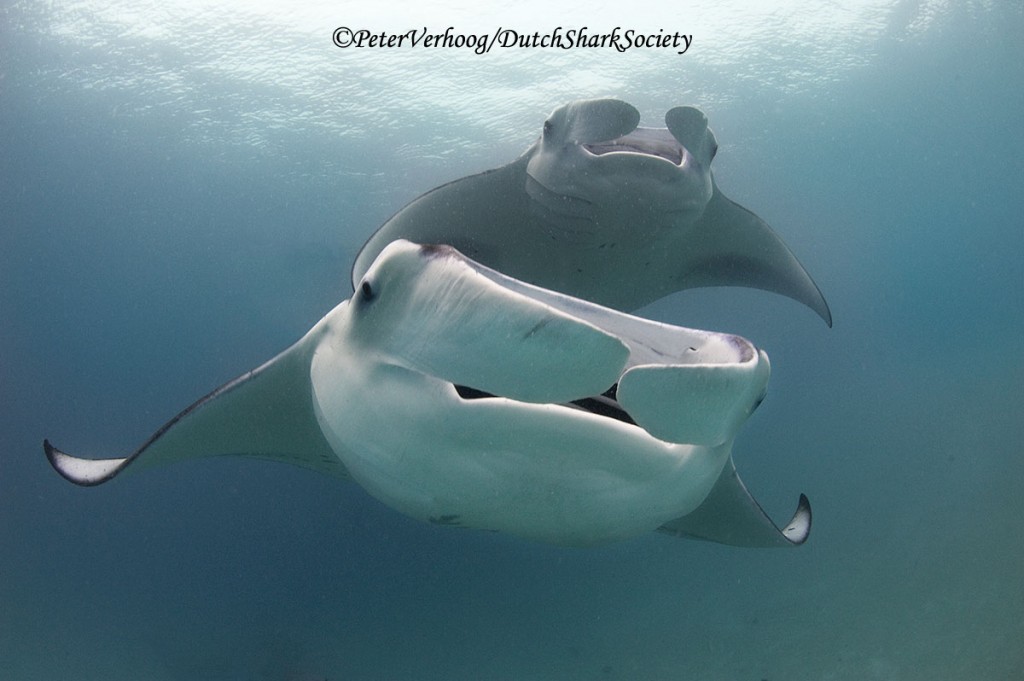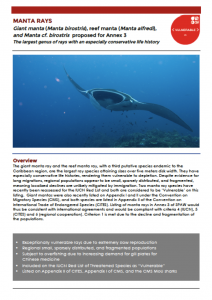Giant manta ray (Manta birostris)
A relatively rare visitor to the waters of the Dutch Caribbean is the giant manta ray, the largest of all ray species. This species grows larger compared to the reef manta (Manta alfredi) and has different coloration patterns and a calcified lump with embedded spine behind the dorsal fin. Unfortunately, like many other shark and ray species, populations of the giant manta ray are still in decline. The rays are often caught accidentally as bycatch in fisheries. In Asia, the species is also targeted for its large gill plates, which are dried and sold separately from the meat and liver oil. These plates are the most valuable part of the animal, as they are believed to have medicinal properties. According to the IUCN, the current status of the giant manta is ‘vulnerable’, which means its populations are declining and the species is at risk of becoming threatened in the near future. For this reason, and because the remaining threat of the gill plate trade, all manta rays are listed on Appendix II of CITES (the international organization that regulates the trade in endangered species).
The giant manta has a so-called circumtropical distribution, meaning it occurs in all tropical waters of the world’s oceans (between 40° North and South). It can also be encountered in sub-tropical waters and mainly occurs in regions with frequent upwelling, islands or seamounts. Although mainly residing in shallow waters, the giant manta can also dive to great depths exceeding 1,000 meters. Mantas often show seasonal patterns in their movements and can undertake seasonal migrations of more than 1,100 km. The species often aggregates in groups to feed, mate, or to be cleaned of parasites by smaller reef fish. The giant manta is thought to live a more solitary lifestyle than the smaller reef manta.
The two manta ray species, together with the mobula rays, differ from other rays by the position of their mouth, which is located on the front side of the head, whereas on other rays the mouth is positioned more ventrally. The giant manta ray can reach a maximum size/disc width (i.e. the distance between the tips of both pectoral fins) of 700 cm, but anecdotal evidence suggests that this species can grow up to 910 cm disc width. Like many other shark and ray species, the giant manta reaches sexual maturity at a relatively large size, 380-410 cm for females and 360-380 cm for males. These lengths at maturity correspond to an age of approximately 8 to 10 years. Longevity of this species is estimated to exceed 40 years. Like many shark species, the giant manta is ovoviviparous, which means it develops and hatches eggs within the uterus after which the pups are born. Normally the giant manta only gets one or two pups measuring around 120 cm when they are born.

IUCN REDLIST STATUS:

The giant manta ray is one of the eight shark species that are now officially protected under the international Specially Protected Areas and Wildlife (SPAW) Protocol, which is the only cross-border legislative instrument for nature conservation in the Wider Caribbean Region. This fact sheet with information about the species was produced to support the proposals for listing.






